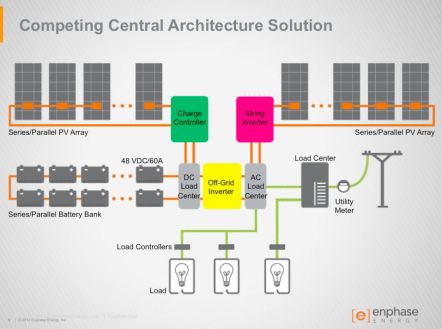Enphase didn't exhibit at last year's Solar Power International, but the microinverter specialist has traveled to Las Vegas this year with an improved microinverter -- and a bit of a surprise.
5th generation microinverter
Paul Nahi, Enphase's CEO, said the firm's fifth-generation microinverter is its "most technologically advanced microinverter -- this was not even possible to do when we started the company."
He noted that the 275-watt, 97 percent CEC efficiency microinverter "needed to address the complexity of the grid" with reactive power control, volt/VAR and ride-through.

Enphase claims that the new device is Rule 21-ready. (Rule 21 regulates grid-interconnected distributed generation resources, including customer-owned solar.) The unit is also fully bidirectional.
The storage surprise
Nahi called the advent of storage "a seminal moment for energy" and the "first time that we are going to be Enphase Energy." He said that the firm is leveraging years of R&D and patents to introduce an energy management system along with a modular plug-and-play battery. The management system looks to combine grid smarts, analytics, communications and energy storage, along with advanced control capabilities and load management.
Enphase co-founder and VP of products and strategic initiatives Raghu Belur spoke of distributed hardware, software and power electronics as an operating system, saying, "We're talking about a larger platform in which storage is an application."
The microinverter leader seems to have looked at the battery problem through a solar module lens -- the poorest-performing battery in a string sets the standard for the performance of the system. Nahi noted that there are "many points of failure in a storage system -- at the inverter, at the charge controller, or at the battery," making storage systems very complex to install, design and manage. He added, "That complexity drives up cost."
According to Belur, after an extensive global search for the right battery chemistry and vendor, Enphase sourced ELIIY Power's lithium-iron-phosphate battery, a chemistry known for its safe operation which is also used by battery vendor A123. Nahi said that ELIIY is "extremely cost-competitive in this space." Belur noted that with all due respect, he is very surprised by the high prices being quoted for batteries from companies like Tesla or SolarCity.
ELIIY Power is a Japanese battery producer supported by Daiwa House, a large Japanese homebuilder.
The 40-pound AC battery, equipped with a bidirectional microinverter, plugs into the Enphase Energy Management System and is designed for residential and commercial applications. The unit provides 1.2 kilowatt-hours of energy storage and 275-watt/500-watt power output. Belur notes that it only takes one person to hang the 16-inch-wide battery on the wall of a garage.
“Storage is going to be a multi-billion-dollar market, and it will be essential in helping solar gain broader acceptance and higher penetration,” said Belur in a release, adding, "It provides benefits for the system owner, while also helping with grid stability."
Enphase will soon be launching pilot energy storage projects with Lennar Homes, Hawaii Energy Connection and Vivint Solar. The product line rolls out in 2015.
Belur said of the batteries, "We're breaking storage into smaller manageable chunks," adding, "We think we can drive the price down effectively." He continued, "We have abstracted away the chemistry. You can mix and match batteries the way you can mix and match solar panels with microinverters on a roof."
"It's not about defecting from the grid," Nahi said. "If we look at the grid in Australia where PV penetration is high and regulations impose a 'zero-export' rule, the Enphase system is a solution."
Belur suggests, "We are providing the platform for other companies to write their own applications -- the optimization might be for zero export, highest availability or demand charges."
Residential rate structures do not make it easy for energy storage to be economically viable right now in the U.S. Enphase will look at international markets such as Australia to begin building the business.
“The solar industry is dominated by static, isolated systems that do not integrate, communicate, scale or adapt quickly to changes in power generation," said the Enphase CEO, adding, "Enphase is taking a fundamentally different approach to energy management.”
The question of the viability and timing of the energy storage market remains. Some believe the move to ubiquitous energy storage will come sooner than expected. Other studies have suggested that storage is not needed until very high renewables penetration is reached, or that cheap natural gas obviates the need for energy storage.
Enphase will soon find out.





